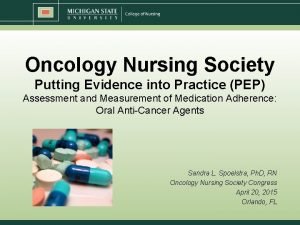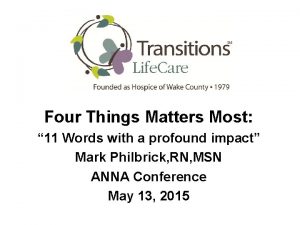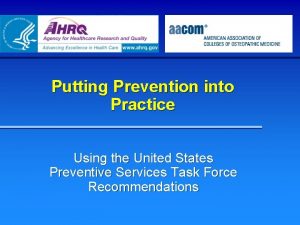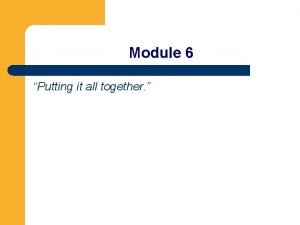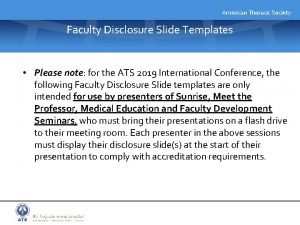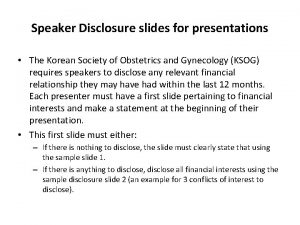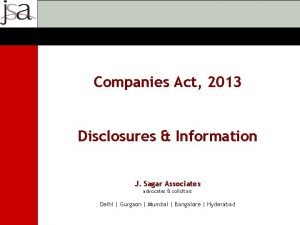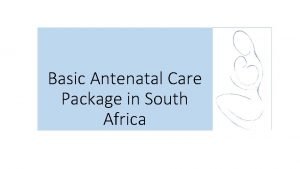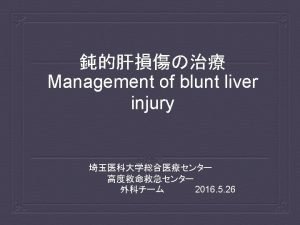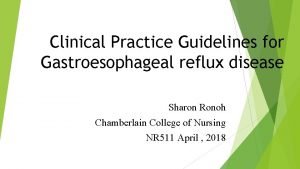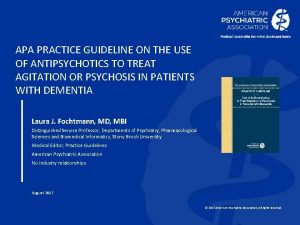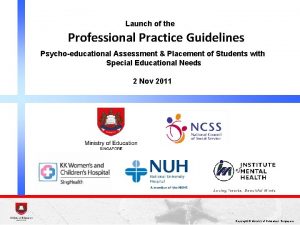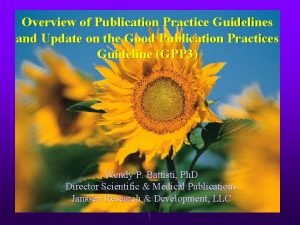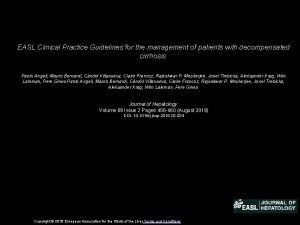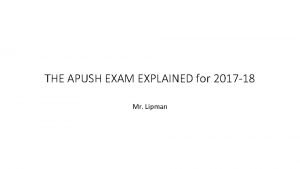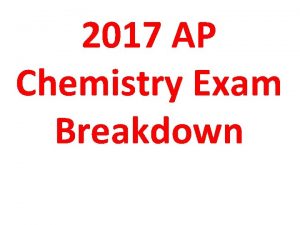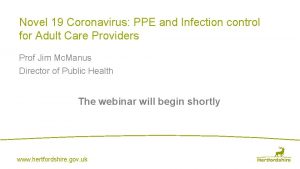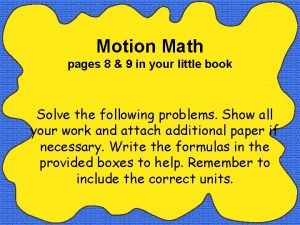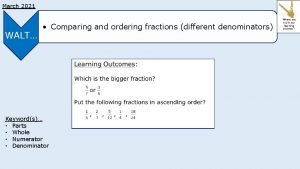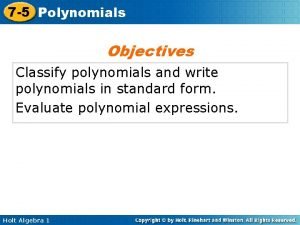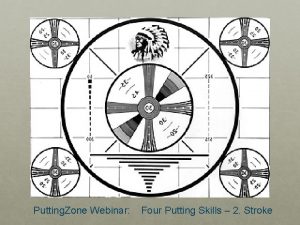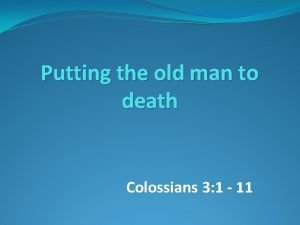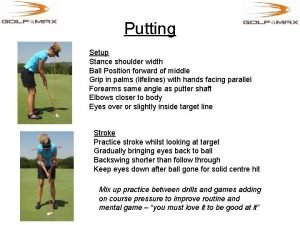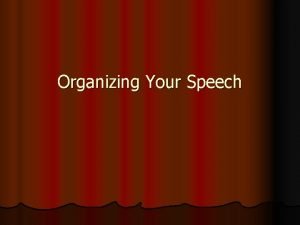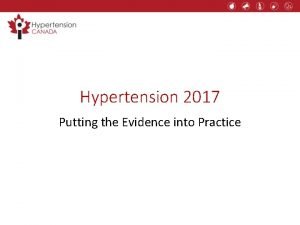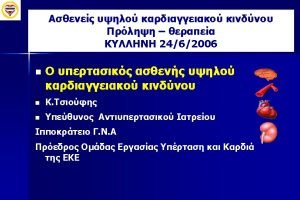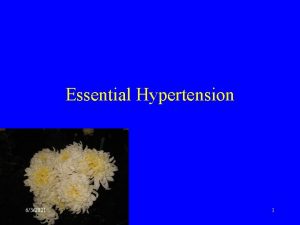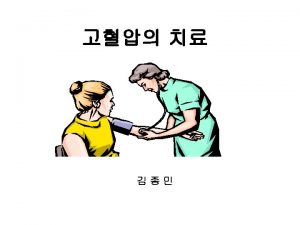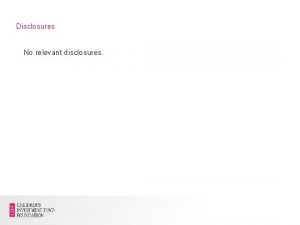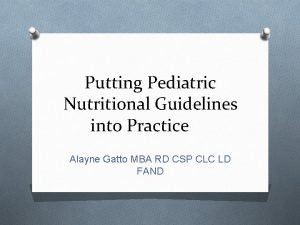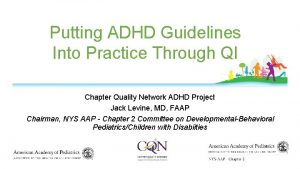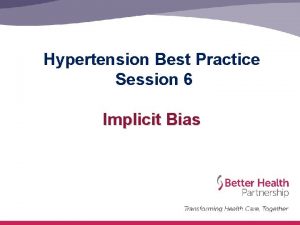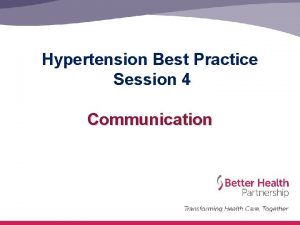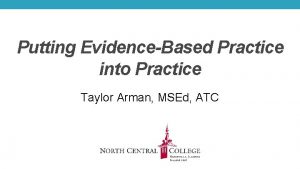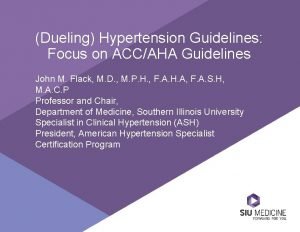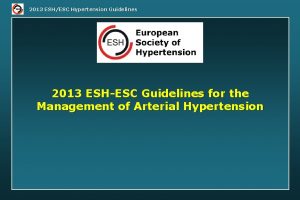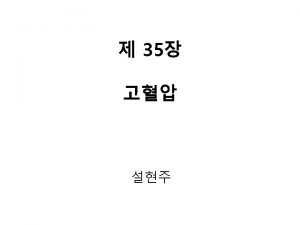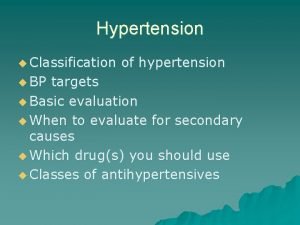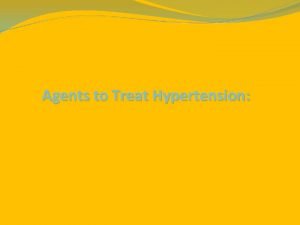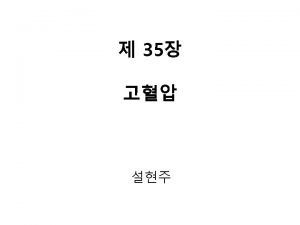Hypertension 2017 Putting the Guidelines into Practice Disclosures











































- Slides: 43

Hypertension 2017 Putting the Guidelines into Practice

Disclosures • Relationships with commercial interests: • Grants/Research Support: • Speakers Bureau/Honoraria: • Consulting Fees: • Data Safety and Monitoring:

Disclosure of Commercial Support • This program has received financial support from Servier in the form of an educational grant • This program has not received any in-kind support • Potential for conflict(s) of interest: • _______has received an honoraria funding from Servier, who has product(s) in this therapeutic area

Mitigating Potential Bias • The information presented is based on recent information that is explicitly ‘‘evidence-based’’ and is solely based on Hypertension Canada Guidelines

Evidence-Based Annual Guidelines • Canada has the world’s highest reported national blood pressure control rates • Hypertension Canada is known as the most credible source for evidence-based hypertension guidelines, with annual updates, a well-validated review process and effective dissemination and implementation techniques across Canada

Learning Objectives At the conclusion of this activity, participants will be able to: • Apply appropriate methods for making a diagnosis of hypertension • Implement evidence-based threshold and target BPs • Integrate new guidelines for hypertension management including: • Use of longer-acting over shorter-acting diuretics • Use of single pill combinations as a first-line treatment

Hypertension 2017 What’s new? • Longer acting (thiazide-like) diuretics are preferred vs. shorter acting (thiazides) • Single pill combinations as a first line treatment (regardless of the extent of BP elevation)

Hypertension 2017 What’s still important? • The diagnosis of hypertension should be based on out-of-office measurements; in the office, use automated office BP monitoring (AOBP) • The threshold and target blood pressures are lower in those at greater risk

Case 1. Office vs. Out-of-Office BP Measurements in the DIAGNOSIS of Hypertension: Which One to Believe? • 57 -year-old account executive presents for BP follow-up visit • Elevated BP identified 2 months ago during annual exam • Interim BPs taken at local pharmacies have all been normal • Normal hematology, biochemistry, renal function and electrolytes • Normal EKG with no evidence of LVH • Office BP using auscultatory wall-mounted mercury sphygmomanometer: 152/102 mm. Hg • How would you explain this observation?

Hypertension Diagnostic Algorithm 1. Out of office assessment is the preferred means of hypertension Dx 2. Measurement using electronic (oscillometric) upper arm devices is preferred over auscultation ABPM = ambulatory blood pressure measurement AOBP = automated office blood pressure

Out-of-Office Assessment is the Preferred Means of Diagnosing Hypertension Clinic BP as alternate method AOBP = automated office blood pressure OBPM = office BP measurement ABPM = ambulatory BP measurement HBPM = home BP measurement

Out-of-Office BP Measurements • Out-of-office measurement identifies white coat hypertension and masked hypertension • ABPM has better predictive ability than OBPM and is the recommended out-of-office measurement method • HBPM has better predictive ability than OBPM and is recommended if ABPM is not tolerated, not readily available or due to patient preference ABPM = ambulatory blood pressure measurement HBPM = home BP measurement OBPM = office BP measurement

Out-of-Office BP Measurements are More Highly Correlated With BP-Related Risk LVH Albumin excretion ratio OBP SBP HBPM SBP ABPM 0 0. 1 0. 2 0. 3 0. 4 0. 5 0. 6 0 0. 1 0. 2 0. 3 0. 4 0. 5 OBP DBP HBPM DBP ABPM 0 0. 1 0. 2 0. 3 0. 4 0. 5 0. 6 Indexes of hypertensive target organ damage Mulè G, et al. J Cardiovasc Risk 2002; 9: 123 -9.

White Coat and Masked Hypertension Derived from Pickering TG, et al. Hypertension 2002: 40: 795 -6. Ambulatory BP mm. Hg 200 180 160 MASKED HYPERTENSION TRUE HYPERTENSION NORMOTENSION WHITE COAT HYPERTENSION 140 135 120 100 120 140 160 180 200 Manual Office BP mm. Hg Derived from Pickering TG, et al. Hypertension 2002: 40: 795 -6.

CV events per 1000 patient-year The Prognosis of White Coat and Masked Hypertension 35 CV Events 30 25 20 15 10 5 0 Normal White coat Uncontrolled Masked Okhubo T, et al. J Am Coll Cardiol 2005; 46; 508 -15

Automated Office BP Measurement Preferred • Automated office blood pressure (AOBP) is the preferred method of performing in-office BP measurement Automated Office (unattended, AOBP) Oscillometric (electronic)

Automated Office BP Measurement • More closely approximates ABPM than routine office BPs (mitigates white coat effect)1 -3 • Is more predictive of end organ damage (LVMI, proteinuria and c. IMT), similar to ABPM 4 -6 ABPM = ambulatory blood pressure measurement LVMI = left ventricular mass index c. IMT = carotid intima media thickness 1. Beckett L, et al. BMC Cardiovasc Disord 2005; 5: 18; 2. Myers MG, et al. J Hypertens 2009; 27: 280 -6; 3. Myers MG, et al. BMJ 2011; 342; d 286; 4. Campbell NRC, et al. J Hum Hypertens 2007; 21: 588 -90; 5. Andreadis EA, et al. Am J Hypertens 2011; 24: 661 -6; 6. Andreadis EA, et al. Am J Hypertens 2012; 25: 969 -73.

Reflection Case 1 • What device do you currently use in the office to measure BP? • What do you tell patients about home BP assessment?

Hypertension 2017 What’s still important? • The diagnosis of hypertension should be based on out-of-office measurements; in the office, use automatic office BP monitoring (AOBP) • The threshold and target blood pressures are lower in those at greater risk

Case 2. BP Control: A Moving Target? • Jim is 76 years old, recent MI 2 years ago • Comes to the office for hypertension follow-up, no residual angina • Hypertension known for the last 20 years with BP ~135/80 mm. Hg average at home • Rx: amlodipine 5 mg qd, olmesartan 20 mg qd, hydrochlorothiazide 25 mg qd, bisoprolol 5 mg qd for hypertension • Normal cardiovascular exam today, office BP 135/80 mm. Hg • Normal hematology, LDL-C at target, creatinine and electrolytes within normal limits • EKG with anterior infarct, no LVH, normal LV function on echo • What should be his BP target?

Usual Office BP Threshold Values for Initiation of Pharmacological Treatment Population SBP DBP High Risk (SPRINT population) # ≥ 130 NA Diabetes ≥ 130 ≥ 80 Moderate * ≥ 140 ≥ 90 Low risk (no TOD or CV risk factors) ≥ 160 ≥ 100 AOBP = automated office blood pressure TOD = target organ damage SBP = systolic blood pressure DBP = diastolic blood pressure # Based on AOBP *AOBP threshold 135/85 mm. Hg

Recommended Office BP Treatment Targets Treatment consists of health behaviour ± pharmacological management Population SBP DBP High Risk # < 120 NA Diabetes < 130 < 80 All others* < 140 < 90 Based on AOBP *AOBP threshold 135/85 mm. Hg #

New Guideline Post-SPRINT • For high-risk patients, aged ≥ 50 years, with systolic BP levels ≥ 130 mm Hg, intensive management to target a systolic BP ≤ 120 mm Hg should be considered • Intensive management should be guided by automated office BP measurements • Patient selection for intensive management is recommended and caution should be taken in certain high-risk groups

New Thresholds/Targets for the High-Risk Patient Post-SPRINT: Who does this apply to? Clinical or sub-clinical cardiovascular disease OR Chronic kidney disease (non-diabetic nephropathy, proteinuria <1 g/d, *estimated glomerular filtration rate 20 -59 m. L/min/1. 73 m 2) OR †Estimated 10 -year global cardiovascular risk ≥ 15% OR Age ≥ 75 years • There was an increased risk of renal deterioration, potassium abnormalities and hypotension with intensified therapy • Patients with one or more clinical indications should consent to intensive management Four variable MDRD equation Framingham Risk Score, D'Agastino, Circulation 2008 * †

New Thresholds/Targets for the High-Risk Patient Post-SPRINT: Who does this NOT apply to? Limited or No Evidence: • Heart failure (EF <35%) or recent MI (within last 3 months) • Indication for, but not currently receiving, a beta-blocker • Institutionalized elderly Inconclusive Evidence: • Diabetes mellitus • Prior stroke • e. GFR < 20 ml/min/1. 73 m 2 Contraindications: • Patient unwilling or unable to adhere to multiple medications • Standing SBP <110 mm. Hg • Inability to measure SBP accurately • Known secondary cause(s) of hypertension

Reflection Case 2 • Do you document BP targets on the patient's chart/EMR? • How do you communicate BP targets to your patient?

Hypertension 2017 What’s new? • Longer acting (thiazide-like) diuretics are preferred vs. shorter acting (thiazides) • Single pill combinations should be used as a first line treatment (regardless of the extent of BP elevation)

Case 3. Diuretics for Hypertension: A Fluid Situation? • Matthew, a smoker, 53 years of age, is director of finances at your hospital • A diagnosis of stage 1 HTN was made at his annual medical exam 2 years ago • He lost 15 pounds, walks to work everyday, but is unable to stop smoking • Hb. A 1 c and lipids are normal • No signs or symptoms of target organ damage • His initial Rx was hydrochlorothiazide 25 mg qd but with home BP readings averaging 154/90 mm. Hg in the AM before meds and 132/84 in the PM • You consider other options: leave things as they are? add another drug?

Longer-acting Diuretics Should be Preferred (i. e. , thiazide-like are preferred to thiazides) Longer-acting (thiazide-like): chlorthalidone, indapamide Shorter-acting (thiazides): hydrochlorothiazide

Diuretic Type Meta-Analysis vs. Placebo • Both types of diuretics reduced CV events, cerebrovascular events, and HF • Only thiazide-like diuretics additionally reduced coronary events and all-cause mortality Event Thiazide-Type Thiazide-Like CV 0. 67 (. 56 -. 81) 0. 67 (0. 60 -0. 75) Coronary 0. 81 (0. 63 -1. 05) 0. 76 (0. 61 -0. 96) Cerebrovascular 0. 52 (0. 38 -0. 69) 0. 68 (0. 57 -0. 80) Heart Failure 0. 36 (0. 16 -0. 84) 0. 47 (0. 36 -0. 61) All-cause Mortality 0. 86 (0. 75 -1. 00) 0. 84 (0. 74 -0. 96) Olde Engberink RH. Hypertension 2015; 65(5): 1033 -40

Chlorthalidone More Effective Than Hydrochlorothiazide in BP Reduction Mean change from baseline at week 12 0 Ambulatory SBP Ambulatory DBP -2 -4 -6 -4. 17 -6. 02 -8 -7. 78 -10 -12 -14 -11. 14 HCTZ (n=18) Chlorthalidone (n=16) P=0. 007 P<0. 001 Kruskal-Wallis test used with Dunn’s test for multiple comparisons; comparison between baseline and Wilcoxon signed rank test results. Mean 24 h SBP was significantly lower for the chlorthalidone group than for the HCTZ group at week 4 (125. 52 vs. 139. 71 mm. Hg, respectively, P=0. 019) and week 12 (121. 87 vs. 136. 64 mm. Hg, respectively, P=0. 013). Intent-to-treat population. Pareek AK, et al. J Am Coll Cardiol 2016; 67(4): 379 -89

Summary: Longer-Acting Diuretics Preferred • Longer-acting (thiazide-like) diuretics appear more effective at reducing CV events and SBP & DBP than shorter-acting (thiazide) diuretics

Reflection Case 3 • In patients who are currently taking a short-acting diuretic and have good blood pressure control, should you change their therapy? • How are you determining what constitutes good blood pressure control?

Hypertension 2017 What’s new? • Longer acting (thiazide-like) diuretics are preferred vs. shorter acting (thiazide) • Single pill combinations should be used as a first line treatment (regardless of the extent of BP elevation)

Case 4. Lightening the Load in the Management of the Patient with Multiple Risk Factors • Wally is a 59 -year-old who has a remote history of prediabetes, mild hypertension and dyslipidemia. You haven’t seen him for 3 years – he says “I just got tired of taking all those pills. ” • Motivated by his family (older sib just had an MI), Wally presents for reassessment of his CV risks, with these results: BP 146/92, Hb. A 1 c = 6. 8%, LDL = 3. 9. • As you consider his antihypertensive therapy, Wally says wistfully – “Bet you’re gonna load me up with pills again…” • What antihypertensive therapy would you consider for this patient?

First Line Recommendations Circa 1999 -2016 TARGET < 140 mm. Hg systolic AND < 90 mm. Hg diastolic Health behaviour management Thiazide diuretic ACEi ARB Long-acting CCB Betablocker* A combination of 2 first line drugs may be considered as initial therapy if the blood pressure is ≥ 20 mm. Hg systolic or ≥ 10 mm. Hg diastolic above target *Not indicated as first line therapy for patients over 60 yrs.

First Line Treatment of Adults with Systolic/Diastolic Hypertension Without Other Compelling Indications 017 2 w e TARGET <135/85 mm. Hg (automated measurement method) N INITIAL TREATMENT Health behaviour management Thiazide/ thiazide-like* ACEI§ ARB § Long-acting CCB Betablocker† Single pill combination** * Longer-acting (thiazide-like) diuretics are preferred over shorter-acting (thiazide) diuretics † BBs are not indicated as first line therapy for age 60 and above §Renin angiotensin system (RAS) inhibitors are contraindicated in pregnancy and caution is required in prescribing to women of child bearing potential **Recommended SPC choices are those in which an ACE-I is combined with a CCB, an ARB with a CCB, or an ACE-I or ARB with a diuretic

Advantages of Single Pill Combinations (SPCs) • SPC therapy is associated with better adherence vs. free combinations 1 • A regimen featuring initial prescription of SPC leads to better BP control 2 • Initial combination therapy is associated with ↓ risk of CV events than monotherapy 3, 4 1. Sherrill B, et al. J Clin Hypertens 2011; 13: 898 -909; 2. Feldman RD, et al. Hypertension 2009; 53: 646 -53; 3. Corrao G, et al. Hypertension 2011; 58: 566 -72; 4. Gradman AH, et al. Hypertension 2013; 61(2): 309 -18.

SPC Combining an ACEI/ARB With CCB/Diuretic as First Line Rx 2 key studies establishing the utility of SPCs as first line: HOPE-3. N Engl J Med 2016; 374(21): 2009 -20 Pivotal study demonstrating the superiority of an SPC (ARB/diuretic) vs. Placebo ACCOMPLISH. N Engl J Med 2008; 359(23): 2417 -28 Demonstration of efficacy of ACEI/CCB SPC vs. active control

Reflection Case 4 • Will you start patients with newly diagnosed mild hypertension on single pill combination therapy? • What are the barriers to prescribing SPCs?

Hypertension 2017 What’s new? • Longer-acting (thiazide-like) diuretics are preferred vs. shorter-acting (thiazides) • Single pill combinations as a first line treatment (regardless of the extent of BP elevation)

Hypertension 2017 What’s still important? • The diagnosis of hypertension should be based on out-of-office measurements; in the office, use automated office BP measurement (AOBP) • The threshold and target blood pressures are lower in those at greater risk

hypertension. ca For patients: • Free access to the latest information and resources For professionals: • Accredited 15. 5 hour interdisciplinary training program • Free monthly news updates, featured research and educational resources • Become a member for special privileges and savings
 The pricing tripod
The pricing tripod Putting evidence into practice
Putting evidence into practice Putting it into practice
Putting it into practice Putting prevention into practice
Putting prevention into practice Coherent curriculum
Coherent curriculum Putting the enterprise into the enterprise system
Putting the enterprise into the enterprise system Enterprise
Enterprise Practice notebook - putting it all together
Practice notebook - putting it all together Disclosure slide for powerpoint
Disclosure slide for powerpoint Voluntary disclosures meaning
Voluntary disclosures meaning Disclosure slide presentation
Disclosure slide presentation Website disclosures under companies act 2013
Website disclosures under companies act 2013 No disclosures
No disclosures Banc plus
Banc plus American thyroid association guidelines pregnancy 2017
American thyroid association guidelines pregnancy 2017 East guideline
East guideline Gerd clinical practice guidelines
Gerd clinical practice guidelines Apa practice guidelines
Apa practice guidelines Good regulatory practice guidelines
Good regulatory practice guidelines Professional practice guidelines moe
Professional practice guidelines moe Good publication practice for pharmaceutical companies
Good publication practice for pharmaceutical companies Easl guidelines decompensated cirrhosis
Easl guidelines decompensated cirrhosis Apush exam layout
Apush exam layout 2017 ap chemistry practice exam
2017 ap chemistry practice exam 2017 asco oncology practice conference
2017 asco oncology practice conference Putting-out system
Putting-out system What is nasreen putting chocolate on
What is nasreen putting chocolate on Putting-out system
Putting-out system Putting-out system
Putting-out system After putting the pieces together, what do they look like?
After putting the pieces together, what do they look like? Putting objects in perspective
Putting objects in perspective The order of putting on ppe
The order of putting on ppe Putting it all together motion answer key
Putting it all together motion answer key Ordering fractions with different denominators
Ordering fractions with different denominators Putting people first 2007
Putting people first 2007 Putting-out system
Putting-out system Classify the polynomial
Classify the polynomial Letters put together
Letters put together A 3-d work of art created by shaping or combining materials
A 3-d work of art created by shaping or combining materials Putting zone
Putting zone Put to death the old man
Put to death the old man Putting stance width
Putting stance width Package mypackage; class first { /* class body */ }
Package mypackage; class first { /* class body */ } Putting a speech together in a particular way
Putting a speech together in a particular way

